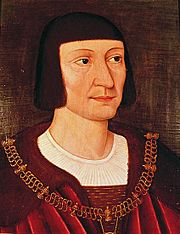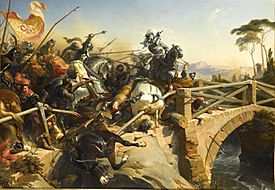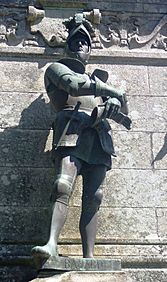Pierre Terrail, seigneur de Bayard facts for kids
Quick facts for kids
Pierre Terrail, seigneur de Bayard
|
|
|---|---|
 |
|
| Born | c. 1476 Château Bayard |
| Died | 30 April 1524 (aged 47–48) Romagnano Sesia |
| Allegiance | |
| Battles/wars | Italian War of 1494–1498
Italian Wars of 1499–1504
|
| Awards | Order of Saint Michael |
| Signature | |
Pierre Terrail, known as the Chevalier de Bayard, was a famous French knight and military leader. He lived from about 1476 to 1524. He was a key figure during the time when the Middle Ages were ending and the Renaissance was beginning. People called him "the knight without fear and beyond reproach." But he liked being called "the good knight" because he was cheerful and kind.
Contents
Bayard's Character and Look
Bayard was described by his squire and biographer, Jacques de Mailles. He had a sharp, pale face with brown hair and bright, attentive eyes. He also had a long nose. As a child, Bayard was small, but he grew quite tall as a teenager. Studies of his skull suggest he was about 1.8 meters (5 feet 11 inches) tall, which was taller than most people at that time.
The French historian Aymar du Rivail said Bayard was "courteous, cheerful; not proud, indeed modest." Bayard strongly believed in the knight's code of honor. He always showed respect for people who were weak or defeated. He would get very angry when he saw cruelty or unfairness. Unlike other soldiers, he even paid for supplies he needed from farmers. Other soldiers would often just take things by force.
Bayard's kindness was so well-known that people in Italy would come out to meet his troops. They would cheer his name and offer him gifts. This was unusual, as people usually ran away from armed soldiers.
Even though he was kind, Bayard was a fierce fighter in battle. He was very tough on his enemies and himself. He had strong religious faith since he was a child. He believed God wanted him to be a knight. He always put himself in God's hands before every battle.
Early Life and Training
Bayard came from a noble family with a long history of military service. Three generations of his ancestors had died in battle between 1356 and 1465. He was born at the Château Bayard in Dauphiné, southern France.
When he was young, Bayard served as a page to Charles I of Savoy, a young Duke. The Duke died in 1490. At age thirteen, Bayard impressed King Charles VIII of France with his amazing horse riding skills. This earned him the nickname "piquet" (spur).
Serving King Charles VIII
In 1490, Bayard became a man-at-arms for Louis de Luxembourg, a favorite of King Charles VIII. As a young man, Bayard was known for his good looks, charming personality, and skill in knightly games.
In July 1494, a tournament was held in Lyons. The king and his court were there. Even though Bayard was not yet eighteen, he won the top honors. This again brought him to the king's attention.
First Italian War (1494-1498)
In 1494, Bayard joined King Charles VIII's army in Italy. The king wanted to take control of the Kingdom of Naples. This campaign is now known as the Italian War of 1494–1498.
Battle of Fornovo (1495)
Bayard became a knight after the Battle of Fornovo in 1495. During this battle, he captured an enemy flag. Soon after, he rode alone into Milan chasing the enemy. He was captured but was set free without having to pay a ransom by Ludovico Sforza.
Duel with Sotomayor (1502)
Bayard became truly famous in Italy after an event in 1502. A French soldier named Gaspar captured Alonso de Sotomayor, a very large and strong Spanish knight. Bayard took care of Sotomayor to make sure he was treated well. He welcomed him into his home and treated him with respect.
However, after Sotomayor was freed, he accused Bayard of treating him badly. Bayard was very angry and challenged Sotomayor to a duel to the death. Bayard was suffering from serious attacks of malaria at the time. His friend Bellabre offered to fight in his place, but Bayard refused. He wanted to defend his own honor.
On the day of the duel, Bayard had just recovered from a fever. He prayed and then waited for his opponent. Sotomayor made him wait a long time in his armor under the sun. He hoped to make Bayard tired. Sotomayor then demanded they fight on foot with a dagger. Knights usually fought on horseback with a lance and sword. He hoped Bayard would back out. But Bayard agreed.
Sotomayor tried to tire Bayard by making fake attacks. He kept raising his sword with both hands to strike Bayard's head. Bayard always dodged. The fourth time Sotomayor did this, Bayard quickly moved forward. He stabbed the Spaniard's exposed throat with his sword. Then he finished him by planting his dagger in one eye.
The French soldiers cheered loudly, but Bayard told them to be quiet. He did not want to celebrate death. He went to a church and prayed for the soul of the dead man.
Battle of Garigliano (1503)

In late 1503, the French army moved towards Naples. They reached the Garigliano river. Spanish troops were nearby. The French built a bridge of boats across the river. They used cannons to stop the Spanish from attacking. After building the bridge, the French set up camp. They decided to wait until spring to advance to Naples.
The French army was too big for one camp, so they split up. Many groups were spread out in nearby villages. The Spanish took advantage of the winter fog and the divided French army. On December 28, they built another bridge and attacked the French camp. The French were caught by surprise and many fled.
Bayard, armed with his sword and spear, stood alone in the middle of the bridge. He challenged about 300 or 400 Spanish soldiers. Even though there were many of them, they could not make him retreat. Arrows, spears, and spades rained down on him. But he dodged them and kept fighting off anyone who tried to cross. His friend Bellabre finally pulled him away to safety. Bayard's brave stand helped cover the retreat of the French army. It gave them time to set up their cannons and prepare for a counterattack.
This heroic act made Bayard even more famous as a knight "without spot and without fear." Even Pope Julius II tried to hire him, but Bayard refused. Despite Bayard's bravery, the French army suffered a huge defeat at Garigliano. Most of their soldiers were lost. The remaining troops surrendered a few days later.
Serving King Louis XII (1508-1515)
In 1508, Bayard joined King Louis XII to fight against rebellious Genoa. In the battle that crushed the rebellion, Bayard was a champion. He led a very fast cavalry charge up a mountain slope. They attacked a strong barricade defended by Genoese soldiers. The Genoese broke and ran away from Bayard's furious charge. Genoa then fell, and Bayard entered the city in victory with his king.
Later that year, King Louis XII hosted the Spanish king, Ferdinand. There were weeks of celebrations, including tournaments, parties, and dances. Bayard was the champion of the first tournament. At the last event, he met Gonzalo Fernández de Córdoba, "The Great Captain" of Spain. This was his former opponent from the Garigliano.
Battle of Agnadello (1509)
In 1509, the League of Cambrai was formed. It included France, the Holy Roman Empire, Spain, and the Papacy. Their goal was to take land from Venice in northeastern Italy. For this campaign, the king asked Bayard to create a company of horse and foot soldiers. Before this, French foot soldiers were often looked down upon. Bayard's company became a model of good discipline and high spirits. They were very effective in battle. They played a key role in rescuing the French army at the Battle of Agnadello on May 14, 1509.
Siege of Padua (1509)
Later that year, Bayard was with the French forces under Jacques de La Palice. They joined their German ally, Emperor Maximilian I, at the Siege of Padua. The siege eventually failed. However, any early success the allies had was largely due to Bayard's calm leadership and daring bravery.
After the Emperor ended the siege, Bayard and 300 men stayed in Verona. Bayard successfully carried out many raids and ambushes against Venetian forces nearby. He showed himself to be a master of "small war" and good at leading what we would now call "special operations."
In 1510, the Duchy of Ferrara joined the alliance. Bayard was a co-commander of the French group sent to help the city and its Duke, Alphonso d'Este. During his eight months there, Bayard earned the respect of the Duke and his wife, Lucrezia Borgia. Bayard admired Lucrezia, calling her "a pearl" among women. He visited Ferrara again to see her, once with Gaston de Foix, duc de Nemours, just before the Battle of Ravenna where the Duke died.
Holy League (1511)
By 1511, the League of Cambrai had fallen apart. The Pope was worried about France's growing power in Italy. To stop this, Pope Julius II created the Holy League. This alliance put France against the Pope, the Holy Roman Empire, Spain, and the Swiss.
In various small fights with papal troops around Ferrara, Bayard continued to gain fame. In one case, he almost captured the Pope himself. Around this time, Duke Alphonso and Bayard were excommunicated by the Pope. It is not clear how long Bayard remained excommunicated.
Siege of Brescia (1512)
At the Siege of Brescia in 1512, Bayard led a group of dismounted soldiers against the city's defenders. He was at the very front of the attack. Several times, the French attack was pushed back. Each time, Bayard rallied his forces and led them in new attacks. His boldness led to a serious wound in his thigh. But not before the defenses were broken and the French entered the town.
Soldiers carried Bayard to a nearby mansion. It belonged to a nobleman, whose wife and daughters Bayard protected from harm. Bayard was charmed by the young daughters, who sang to him every night. Before his wound healed, he heard that a battle was coming at Ravenna. He quickly left to rejoin his comrades. He gave the two daughters a thousand gold ducats each. This was the money the lady of the house had paid him as ransom for her family.
Battle of Ravenna (1512)
Bayard joined his commander and friend, Gaston of Foix, Duke of Nemours, in time for the important Battle of Ravenna (1512). Bayard's bravery and the French cavalry won the day. However, the Duke was killed in the final hour. This made the battle a strategic loss for the French and a sad event for Bayard.
Battle of the Spurs (1513)
In 1513, Henry VIII of England defeated the French at the Battle of the Spurs. Bayard tried to rally his countrymen, but his escape was cut off. He did not want to surrender. He suddenly rode up to an English officer who was resting without his weapons. Bayard told him to surrender. The English knight agreed. Then, Bayard gave himself up to his prisoner. He was taken to the English camp. But his bravery impressed King Henry, just as it had impressed Ludovico. The king released him without ransom. He only asked Bayard not to serve in battle for six weeks.
Serving King Francis I and Death

When Francis I became king in 1515, Bayard was made lieutenant-general of Dauphiné. But he soon went with the King and the army into Milan. The Swiss were also fighting for control of Milan. At the Battle of Marignano, the armies fought a long and bloody battle. The French won mostly because of the bravery of Bayard, King Francis, and the French armored lancers. After the battle, Bayard had the honor of making his young king a knight.
Siege of Mézières (1521)
When war broke out again between Francis I and Charles V, Holy Roman Emperor, Bayard defended Mézières. He had 1,000 men, and the city was thought to be impossible to defend. But he held it against an army of 35,000 soldiers. After six weeks, he forced the enemy generals to give up the siege. This strong resistance saved central France from being invaded. The king did not have enough soldiers to fight the Holy Roman Empire.
All of France celebrated this achievement. Francis gained time to gather his army, which drove out the invaders in 1521. The French parliament thanked Bayard as the savior of his country. The king made him a knight of the Order of Saint Michael. He also made him commander of 100 soldiers in his own name. This honor was usually only given to princes of the royal family.
Death in Italy (1524)
After stopping a revolt in Genoa and working hard to control a disease in Dauphiné, Bayard was sent to Italy. He was with Admiral Bonnivet. The Admiral was defeated and wounded during his retreat. He asked Bayard to take command and save the army. Bayard pushed back the main attackers. But while guarding the rear of the army at the river Sesia, he was badly wounded by a bullet on April 30, 1524.
He died among his enemies. The Spanish commander Pescara and his old friend Charles, Duke of Bourbon were with him. Bourbon was now fighting on the opposite side. Bayard's body was returned to his friends. He was first buried at Saint-Martin-d'Hères. In 1822, his remains were moved to the Collegiate Church of Saint-André, Grenoble.
Bayard's Legacy
As a soldier, Bayard was seen as the perfect example of chivalry. He was also considered one of the most skilled commanders of his time. He was known for getting very accurate and complete information about enemy movements. He did this through careful scouting and a good spy system.
In armies full of soldiers who fought for money, Bayard remained completely selfless. To the people of his time and those who came after him, he was the fearless and faultless knight. He was known for his romantic heroism, religious devotion, and generosity. His cheerful spirit and kindness also earned him another name from his friends: le bon chevalier (the good knight).
Monuments and Memorials
- There is a statue of him on a horse at Pontcharra (Isère).
- A statue stands at Grenoble, in place Saint-André.
- His tomb, called the Bayard Mausoleum, is in the Saint-André Collegiate church at Grenoble. It was built in 1625.
- The Musée Bayard is at the Château Bayard in Pontcharra.
- A statue was put up in Charleville-Mézières in October 2005. An earlier statue there was damaged in World War I and destroyed by the Germans in World War II.
- There are also statues of him in the Collège Stanislas de Paris, in Saint-Denis, and in Sainte-Anne-d'Auray.
- Clément-Bayard, a car company from Mézières, was named in his honor. His image was used in their logo.
- Adolphe Clément-Bayard, an entrepreneur, created the Clément-Bayard car company in 1903. He later added Bayard to his family name in 1908.
Images for kids
See also
 In Spanish: Pierre Terrail de Bayard para niños
In Spanish: Pierre Terrail de Bayard para niños




